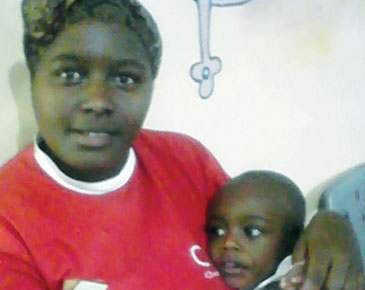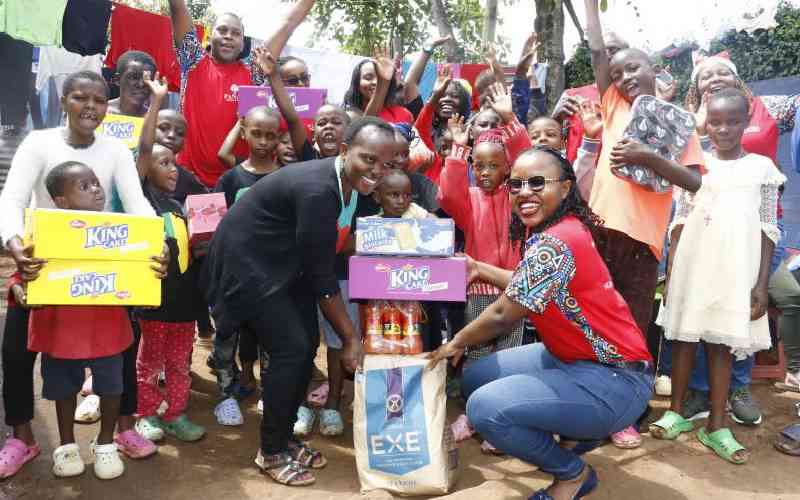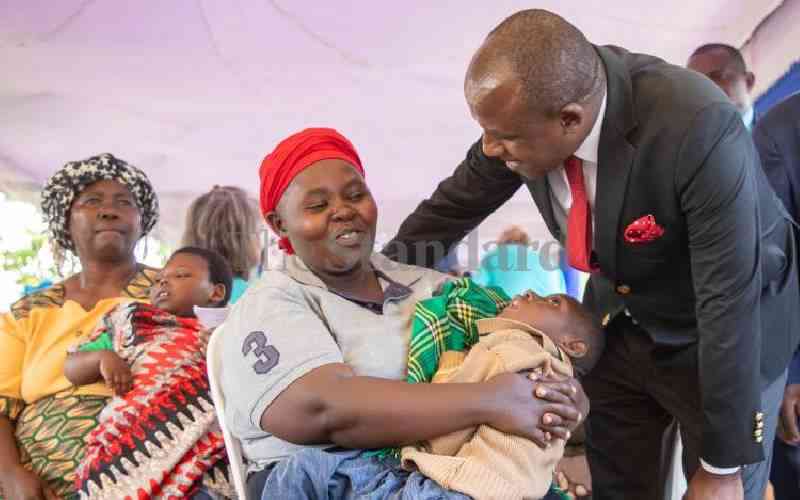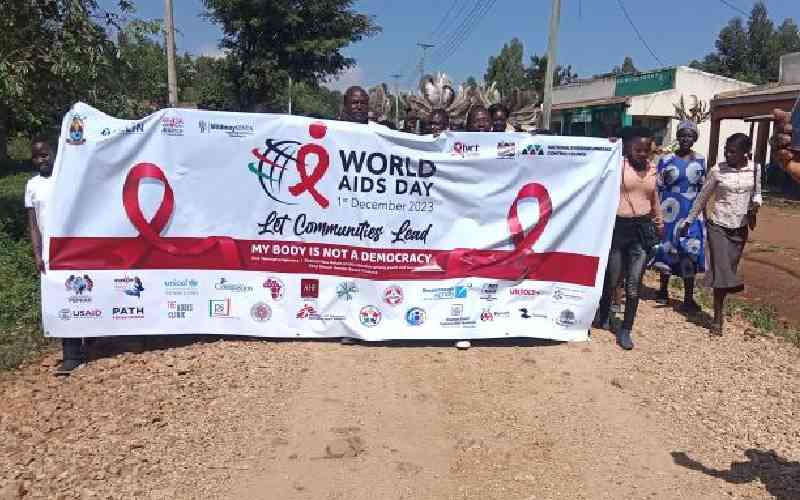 |
|
Perpetua Kimani with her son at the Cerebral Palsy Society of Kenya clinic in Donholm, Nairobi. [PHOTO:DANN OKOTH/STANDARD] |
Nairobi, Kenua: Perpetua Kimani cuddles her one-year-old son Julian at the Cerebral Palsy Society of Kenya Donholm clinic in Nairobi.
The next few hours would be grueling for the 21-year-old mother as she endures an excruciating therapy session for her son who is suffering from cerebral palsy disorder.
The fact that she has had to go through this experience – twice every week – for the last one year does not make today’s appointment any less traumatising.
“It’s been like this for the past one year,” Perpetua says, tears welling in her eyes. “It’s particularly difficult because I have had to go through this alone,” she adds.
Perpetua’s husband left her immediately their son was born with the condition, blaming her for not taking care of herself during pregnancy. She now lives with her parents, whom she says have been very supportive.
Cerebral palsy is a movement disorder caused by an injury to the developing brain, most often before birth.
Signs and symptoms appear during infancy or in pre-school years. In general, cerebral palsy causes impaired movement associated with exaggerated reflexes, floppiness or rigidity of the limbs and trunk, abnormal posture, involuntary movements, unsteadiness of walking, or a combination of all of these.
Furthermore, people with cerebral palsy may have difficulty swallowing and commonly have eye muscle imbalance. Epilepsy, blindness or deafness also may be present.
Although some people with this condition show normal to near-normal intellectual function, often they have underlying developmental brain abnormalities.
According Jardine Mwangeka, CEO of Cerebral Palsy Society of Kenya (CPSK), people with this disorder face a double tragedy – that of rejection by society and lack of care from the Government.
“The most unfortunate thing is that most sufferers are children who cannot speak up for themselves. The society also alienates these children with many being out rightly ostracised from society with traumatic consequences both for the child and parents,” she says.
Create awareness
This is why her organisation has partnered with the Insurance Regulatory Authority (IRA) to create awareness about the condition in the country.
“For the last three years, we have partnered with IRA to create awareness about cerebral palsy with great effect. Since the campaign started, we have received over 300 new cases with 80 being realised in the last year alone,” she says.
This year, the society has teamed up with IRA to conduct a charity walk to create awareness about cerebral palsy and raise funds.
Stay informed. Subscribe to our newsletter
Dubbed ‘Journey of Hope’, the 2014 Cerebral Palsy Charity Walk and Family Fun Day will be held tomorrow at the Nyayo National Stadium from 8am to 4pm. The event targets to raise Sh10 million to fund various rehabilitation services provided by the society.
According to Mwangeka, the Donholm Clinic runs two sessions every week for such children. This, she says, has put a strain on the resources of the society because most of the parents cannot afford normal therapy fee.
“It is worth noting that rehabilitation is very expensive because it involves restoring lost functions and needs a team of paramedics some of who are out of reach for ordinary Kenyans,” Mwangeka observes.
“Currently, we lack the services of speech and language therapists especially because such specialists are rare and expensive to engage,” she adds.
And although people with this condition form about 4.6 per cent of people with disability in the country, there are only about 300 occupational therapists countrywide to attend to them.
To put this into perspective, this averages about six occupational therapists per each county. Each child with cerebral palsy disorder needs at least a two-hour session twice a week with an occupational therapist, which means one such therapist, can only attend to six such children per day. This means they can only attend to 30 children per week.
Cost of therapy
Prohibitively high cost of therapy is also driving huge numbers of such children to miss out on therapy. Although children under five years receive the treatment free-of-charge at Kenyatta National Hospital (KNH) in Nairobi, those above five years are required to pay Sh550 per session. This fee could be as high as Sh3,000 per session in private hospitals.
Mwangeka says the Persons With Disability Act, which created the legal framework to provide the rights and rehabilitation of persons with disability ignored the plight of children with cerebral palsy disorder.
“Consequently, no one from the society or any other relevant body, which caters for the needs of the children, sits on the National Fund for the Disabled of Kenya and therefore does not know how the money is utilised. The law needs to be reviewed in order to take the interests of such children, especially those in rural areas which continue to suffer without hope,” she says.
Evans Kibagenda of IRA says the authority set up a board to identify what sector to support under their Corporate Social Responsibility (CSR), adding that they saw a huge gap in the care of children with cerebral disorder.
“Not only did the board find a huge lack of funding in the sector but also identified the suffering of the children with this condition and the few opportunities that existed for their treatment,” he says.
And for mothers like Kimani who are stuck with cerebral palsy children, such a partnership came like a godsend.
“I would not know what to do without this clinic,” Kimani says, referring to the Donholm CPSR clinic. “They have really assisted me.”
 The Standard Group Plc is a
multi-media organization with investments in media platforms spanning newspaper
print operations, television, radio broadcasting, digital and online services. The
Standard Group is recognized as a leading multi-media house in Kenya with a key
influence in matters of national and international interest.
The Standard Group Plc is a
multi-media organization with investments in media platforms spanning newspaper
print operations, television, radio broadcasting, digital and online services. The
Standard Group is recognized as a leading multi-media house in Kenya with a key
influence in matters of national and international interest.
 The Standard Group Plc is a
multi-media organization with investments in media platforms spanning newspaper
print operations, television, radio broadcasting, digital and online services. The
Standard Group is recognized as a leading multi-media house in Kenya with a key
influence in matters of national and international interest.
The Standard Group Plc is a
multi-media organization with investments in media platforms spanning newspaper
print operations, television, radio broadcasting, digital and online services. The
Standard Group is recognized as a leading multi-media house in Kenya with a key
influence in matters of national and international interest.









